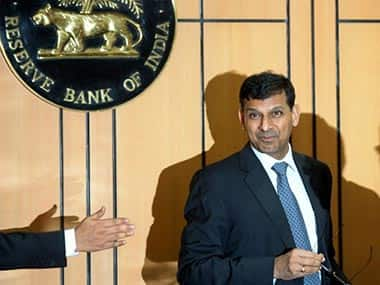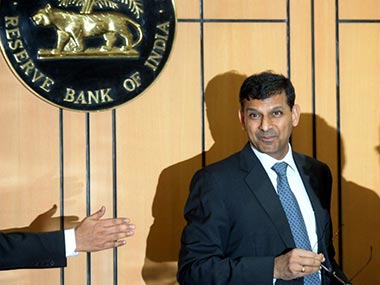Raghuram Rajan is no longer a virgin — he has just announced his first repo rate cut as the governor of the Reserve Bank of India (RBI). Rajan cut the repo rate by 25 basis points (one basis point is one hundredth of a percentage) to 7.75% and in the process took everybody by surprise. Repo rate is the rate at which the RBI lends to banks. [caption id=“attachment_2047475” align=“alignleft” width=“380”]  AFP image[/caption] “To some extent, lower than expected inflation has been enabled by the sharper than expected decline in prices of vegetables and fruits since September, ebbing price pressures in respect of cereals and the large fall in international commodity prices, particularly crude oil. Crude prices, barring geo-political shocks, are expected to remain low over the year. Weak demand conditions have also moderated inflation excluding food and fuel, especially in the reading for December. Finally, the government has reiterated its commitment to adhering to its fiscal deficit target,” Rajan said in a statement explaining why the RBI had chosen to cut the repo rate. Most economists and analysts who follow the moves of the RBI had been saying that a rate cut would come only after the budget was presented in the month of February. “I am very surprised because it goes against the whole current governor’s philosophy that monetary policy should be predictable. It shows the governor is very pragmatic and can look at his own position and can change,” NR Bhanumurthy, Economist, National Institute of Public Finance and Policy told Reuters. Since taking over in September 2013, Rajan has raised the repo rate multiple times to rein in inflation and to protect the crashing rupee. Nevertheless, increases in the repo rate are boring. They only spell gloom and doom. As interest rates go up, corporates don’t invest and you and I don’t borrow to spend, making things a tad unexciting. Repo rate cuts on the other hand are fun - look at the smiles that have come back on the faces of business news anchors for one. The Sensex has also rallied big time. And as I write this, it is up 622.28 points or 2.3% from yesterday’s close while government bond yields fell sharply. The bankers are all happy. And so are the corporates. At least, that’s how things are being portrayed in the media in general and on television in particular. Don’t be surprised tomorrow morning to read newspapers with headlines “your home loan EMIs are ready to fall,” and how real estate companies expect home sales to pick up again. Or to put it in a language that everybody understands these days: “acche din aane waale hain”. “It will provide some fillip to the economy both directly and indirectly,” Arvind Subramanian, chief economic adviser to the ministry of finance said. Finance minister Arun Jaitley, who over the last few months has vociferously been demanding a RBI rate cut said “[the rate cut] will put more money in hands of consumers. [It will be] positive for the Indian economy will help revive investment cycle.” These are fairly simplistic statements. Just because the RBI has cut interest rates by 25 basis points does not mean that corporates and consumers will start borrowing. As John Kenneth Galbraith points out in The Economics of Innocent Fraud: “If in recession the interest rate is lowered by the central bank, the member banks are counted on to pass the lower rate along to their customers, thus encouraging them to borrow. Producers will thus produce goods and services, buy the plant and machinery they can afford now and from which they can make money, and consumption paid for by cheaper loans will expand.” This is the logic that has been offered by both Subramanian and Jaitley. But things play out a little differently in the real world. “The difficulty is that this highly plausible, wholly agreeable process exists only in well-established economic belief and not in real life. The belief depends on the seemingly persuasive theory and on neither reality nor practical experience. Business firms borrow when they can make money and not because interest rates are low,” Galbraith points out. So, corporates are not just going to start borrowing and investing because the repo rate has been cut by 25 basis points. As Bhanumurthy told Reuters: “I don’t think it will have too much impact because investment is not dependent on interest rates alone.” Further, the Indian corporates are heavily leveraged and they are really in no position to borrow more. Banks have already lost too much lending to them and will be very careful lending more. What about consumers? Will they borrow and spend more? Here it is important to go back again to what Galbraith writes in The Affluent Society: “Consumer credit is ordinarily repaid in installments, and one of the mathematical tricks of this type of repayment is that a very large increase in interest brings a very small increase in monthly payment.” And vice versa—a large cut in interest rate decreases the monthly payment by a very small amount. I have often made this argument in the past, nevertheless its worth repeating here. An individual decides to take a car loan of Rs 4.25 lakh at 10.5%, repayable over a period of five years. The monthly payment or the EMI on this loan amounts to Rs 9,134.9. Now let’s say the RBI decides to cut the repo rate by 25 basis points and the bank decides to pass on this rate cut to the consumers (something that doesn’t always happen) and cuts the car loan rate by 25 basis points to 10.25%. The EMI now falls to Rs 9082.4 or Rs 52.5 lower. If the cut is 50 basis points as is being speculated on television channels right now, the EMI will fall by around Rs 105. Is someone going to go buy a car just because the EMI has fallen by a little over Rs 50 or Rs 100? I am sure it takes a lot more than that. For loans of lower denominations the difference in EMIs will be even lower. What about home loans? In that case there is some fall in EMIs, but the basic problem with real estate is that its way too expensive and unless a big fall in price happens, people are not going to buy homes, even if EMIs come down significantly. So what does that leave us with? Not much. Monetary policy impact is over-rated. There are many other factors that need to go right for the economy to be up and running again. The expectation is that Rajan will cut continue to cut rates in the days to come. Shubhada Rao, Chief Economist, YES Bank told Reuters: “We are expecting 50 basis point rate cut between now and June.” Rajan in his statement said: “Key to further easing are data that confirm continuing disinflationary pressures.” This means that if inflation keeps falling, RBI will cut the repo rate more. Nevertheless Rajan also said that “also critical would be sustained high quality fiscal consolidation.” This is where things get interesting. What Rajan is essentially saying is that he is waiting for next financial year’s budget to see what sort of fiscal deficit number does the government come up with. Fiscal deficit is the difference between what a government earns and what it spends. While, the finance ministry mandarins have taken great pains to say that this year’s fiscal deficit target is sacrosanct, no such statements have been made regarding the next year. In the Mid Year Economic Analysis, Subramanian wrote that: “Over-indebtedness in the corporate sector with median debt-equity ratios at 70 percent is amongst the highest in the world. The ripples from the corporate sector have extended to the banking sector where restructured assets are estimated at about 11-12 percent of total assets. Displaying risk aversion, the banking sector is increasingly unable and unwilling to lend to the real sector.” This has led to a situation where banks aren’t interested in lending and corporates aren’t interesting in investing. In order to get around this problem Subramanian suggested that: “it seems imperative to consider the case for reviving public investment as one of the key engines of growth going forward, not to replace private investment but to revive and complement it.” If this were to be implemented it would mean more government spending and a higher fiscal deficit. Higher government spending typically leads to a prospect of high inflation as more money chases the same volume of goods and services. This is something that Rajan will keep a lookout for before deciding to continue with the repo rate cuts. To conclude, for monetary policy to drive private investments and consumer spending, interest rates need to come down by a huge margin (at least around 300-350 basis points). A 25 basis point cut really amounts to nothing.
For monetary policy to drive private investments and consumer spending, interest rates need to come down by a huge margin
Advertisement
End of Article


)

)
)
)
)
)
)
)
)



